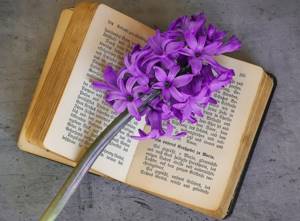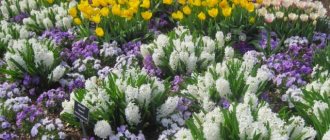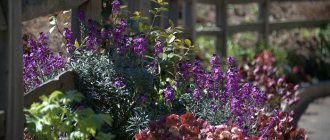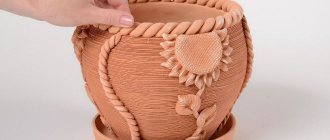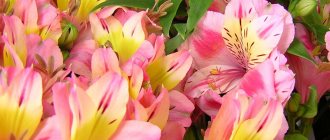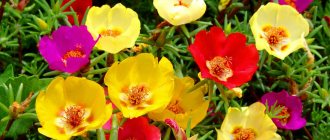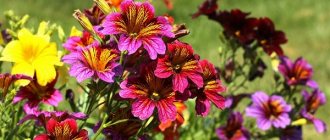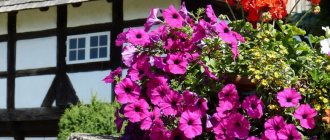Many gardeners look forward to the flowering of their bulbous favorites, the charming hyacinths, in early spring. After a long and dull winter, spring hyacinths delight with their strength and beauty, warm the soul and lift the spirits.
Rain flower - this is how the name Hyacinthus is translated from Greek. Asia Minor and North Africa are considered the birthplace of the flower, but Holland has become the modern hyacinth paradise. Every year, the Dutch city of Haarlem sends millions of varietal bulbs of these colorful plants to all countries of the world.
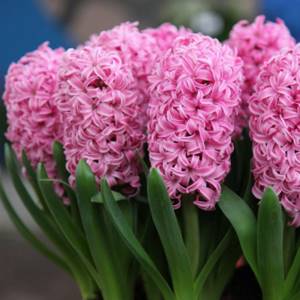
general description
Hyacinth is a bulbous perennial flower belonging to the Asparagus family. The bulb of the plant is large and dense, the circle around its bottom is occupied by fleshy lower leaves. An adult plant produces 1 or 2 flowering stems that reach up to 30 cm in height.

The beautiful appearance of the flower lasts about 2 weeks. After flowering, a bud is formed on the bulb, which over time turns into a new bulb, which already produces a small inflorescence for the next year. In addition to this, other smaller bulbs are formed on the adult bulb, which can also be separated and grown to maturity.
After flowering, the hyacinth flower often produces fruits with three nests containing seeds. An adult bulb has a spherical or wide cone-shaped shape, some varieties are covered with numerous scales.
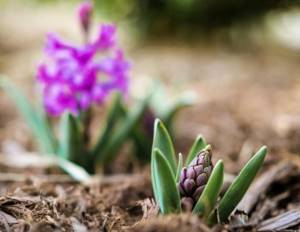
The leaves grow upward and are fleshy and smooth. After the peduncle dies, the leaves lengthen and lie on the ground. Hyacinth flowers have a pleasant aroma; they are collected in racemose inflorescences, on which there are from 12 to 35 flowers.
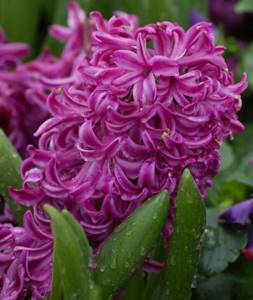
Winter forcing of hyacinths
Hyacinth, cultivation of early forcing is carried out as follows: you need to dig up the bulbs in late June early July, after which they are dried at high temperature and humidity, this is necessary for the normal formation of flower buds. After 2-3 weeks, the temperature is reduced to 25 degrees, and then the bulbs are stored at 17 degrees.
If the forcing is average or late , then dig up the hyacinths 7-10 days later, warm them up for two months at a temperature of about 25 degrees, and then store them at a temperature of 17 degrees. In this case, the bulbs must be cooled; this is done at 9 degrees Celsius for 2 weeks.
After planting, the bulbs transferred to the ground bloom earlier and already at the beginning of spring, you will be able to take photos against the backdrop of these beautiful and pleasantly smelling flowers. Before planting the bulb, it is necessary to separate the baby from it, which will only take away its strength.
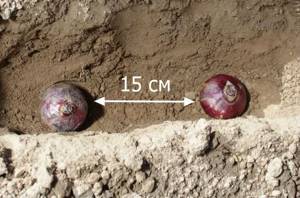
Sometimes it is necessary to adjust flowering to a certain date; to do this, you can speed up or slow down the development process, this is done by adjusting lighting and temperature. If flowering is late, then it is enough to raise the temperature to 21 degrees and extend the sunny day to 12-16 hours, and you can get blooming hyacinth by a certain date. There is no need to pick it, you can take a beautiful photo just like that or give a flower in a pot.
To slow down development, you need to place the plant with buds in a dark and cool place, and 2-3 days before the target date, return it to light and warmth. Half-opened flowers can be stored in such conditions for 10-14 days.
Plant classification
Hyacinths have been grown in home gardens for over 400 years. The main classification includes 3 types of plants:
- eastern, the most popular and widespread type of plant. Almost all known decorative varieties of rain flowers are grown on its basis. These flower stalks come in white, pink, blue or yellow;
- Hyacinth Litvinov. It has wider leaves of a bluish tint, flowers of a predominantly blue color with large stamens;
- Transcaspian flower. Has 1 or 2 inflorescences with light blue flowers.
The above species are the basis for the selection of other subspecies and modifications of the plant.
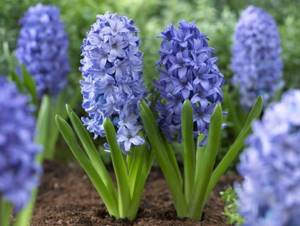
Hyacinths also differ in the shape of the flowers themselves - there are simple and double flowers. According to the flowering period, plants are divided into early, middle and late species.

Based on the color of the flowers (photos of hyacinth are full of the brightest colors), white, blue, pink, raspberry, lemon, lilac and apricot inflorescences stand out. Blue, white and pink hyacinths are usually the first to produce inflorescences in the gardens of our region.
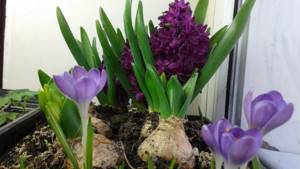
Popular varieties of hyacinth
In modern gardening, three main varieties of hyacinth are grown, belonging to the oriental category:
- Eastern or Dutch hyacinth (H. orientalis) is currently the most common. The bulb forms a single peduncle, the height of which does not exceed 15-23 cm. Flowers in the amount of 30-35 pieces are located on thick pedicels. Flowering lasts two or three weeks.
- Oriental whitish or Franco-Roman hyacinth (H. orientalis var. Albulus) has a certain similarity with H. Orientalis, but has shorter and weaker peduncles, and each bulb produces two or three flowers.
- Oriental Provençal hyacinth (H. orientalis var. Provansalis) is characterized by the formation of low peduncles and fragrant pink flowers.
For landscaping, amateur gardeners quite widely use mouse hyacinth (Muskari) and Litvinov's hyacinth (H. Litwinowii).
How to grow rain flowers correctly
Hyacinths prefer sunny and windless beds. It is advisable to choose surfaces that have a slight slope to allow spring water to drain. Prolonged retention of moisture in the place where flowers grow can destroy the planted bulbs.
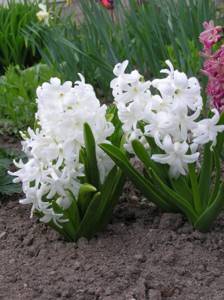
To successfully grow plants, the soil must be permeable and fertilized with humus.

It is not recommended to use fresh organic compounds as fertilizers. If the soil has a clayey and dense base, then it is recommended to “dilute” it with river sand or peat soil.

For successful cultivation and abundant flowering, soil drainage plays an important role.
Combination with other plants
The best combinations are obtained in the form:
- blue hyacinths + yellow daffodils;
- blue hyacinths + white tulips;
- yellow hyacinths + red tulips.
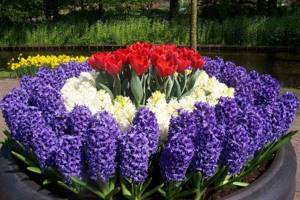
Hyacinths combine with almost all other spring bulbous flowers. The main thing is that they bloom at the same time. Blue and white combinations are the most spectacular.

Planting hyacinths
It is best to prepare the selected area for planting bulbs in early or mid-August, a couple of months before planting. The soil should be dug to a depth of 30-40 cm. Humus, peat or mineral fertilizers such as superphosphate, calcium sulfate or magnesium are added to the soil as fertilizer.
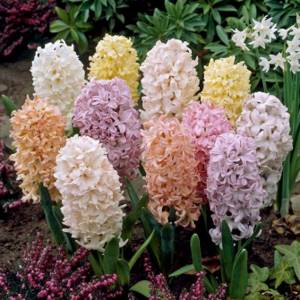
Hyacinths also respond well to the addition of wood ash or dolomite flour. The bulbs must be planted in well-moistened soil in late September or early October. Early planting of hyacinth can lead to premature growth of the plant and its death during frosts.

With the onset of persistently cold days, the bed with planted bulbs should be covered with fallen leaves. In the spring, with the onset of warm days, the shelter is carefully removed from the garden bed. Green sprouts of hyacinths will already be visible under it.
Hyacinths love to be planted in a hole with river sand. Experienced gardeners pour a little sand into the prepared holes, lightly press the hyacinth bulb into the sand, add a little more sand on top, and then add soil.

This operation should definitely be done to reduce the risk of rotting of the bottom of the bulb, improve soil drainage and protect the flower from possible infection.
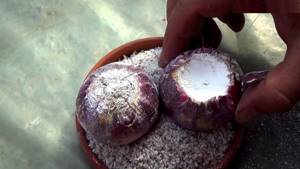
Also, before planting, planting material should be treated with a manganese solution.
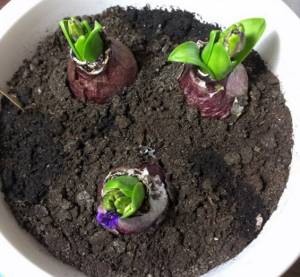
Rules for choosing a site and preparing the soil
Flowering depends on the correct choice of location, so the area intended for hyacinths must have good lighting and protection from cold winds. Sometimes they try to plant bulbs in open ground under trees (photo 1). This partly protects from direct rays of the sun and wind, but after flowering the bulbs suffer due to lack of nutrition.
Growing hyacinths in open ground requires some preparation of the soil, which should be started in advance (preferably in the last months of summer). They require loose soil; for this, river sand or peat is added to the black soil. Acidic soils are not recommended; it is advisable that the acidity does not exceed 6.5 (if higher, the addition of lime flour is required).
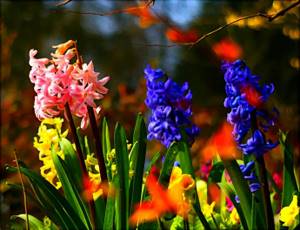
Groundwater located nearby can cause fungus, so good drainage, planting in high beds or creating a slope for better drainage is necessary. Dig the soil 40 cm deep and add (per 1 m²):
- superphosphate - 60 - 80 g;
- wood ash - 200 g;
- limestone - 250 g;
- humus or rotted manure - 10 - 15 kg;
- peat and sand (depending on the condition of the soil).
If hyacinths are planted in spring in sandy soil with a low content of organic and mineral substances, it is necessary to increase the amount of limestone and wood ash by 1.5 times or add (per 1 m²) 45 g of magnesium sulfate and 90 g of potassium sulfate.
The holes are made with a diameter of 15 - 20 cm, deepening the bottom by 15 cm when planting hyacinths in the ground. The bulbs should be buried less into the soil if the planting material is small, and they are placed more densely in the flowerbed.
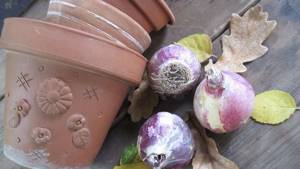
Flower care
Hyacinths prefer weed-free and loosened soil. In spring and summer, flowers need feeding.
In early spring, when the leaves begin to grow, a little superphosphate should be added to the soil; at the budding stage and at the end of flowering, superphosphate should be added along with potassium sulfate. Also, mandatory hyacinth care includes mandatory watering of the plant, which can be reduced after the flowering stage.

Features of planting and care
The question invariably arises: when to plant hyacinths? Bulbs are planted both in the fall (then in March-April they begin to grow) and in the spring.
In central Russia, bulbs are planted in September-October (if planted earlier, they are able to grow and die in winter, if later, there will not be enough time for rooting). It is recommended to lay a layer (3 - 5 cm) of river sand at the bottom of the hole, press the onion into it a little and sprinkle with sand, then soil (photo 2). This will protect them from rotting and improve drainage. In order for the plants to take root better, the plantings should be watered.
With the onset of cold weather, it is necessary to cover the plantings using humus, peat, paws of coniferous trees, dry grass and leaves. Remove the shelter in the spring, after the soil has thawed (hyacinth sprouts appear very early).

If the bulbs are planted in plastic containers for the winter (photo 3), they can be planted in open ground in the spring. The planting technique does not differ from the autumn one; in case of possible cold weather, it is recommended to use peat or sawdust as a shelter for the plants.
Planting is completed, and caring for hyacinths in the open ground consists of loosening the soil, removing weeds and watering (infrequent, but plentiful).
For the purpose of prevention, diseased plants should be removed (culling is carried out 2-3 times per season).
Like planting, feeding is important in spring - in order to develop normally, plants need good nutrition. The first is carried out as soon as sprouts appear (30 g of ammonium nitrate is required per 1 m²). The second time you need to apply fertilizer while painting the buds (per 1 m² 20 g of ammonium nitrate, 40 g of superphosphate, 30 g of potassium chloride).
After flowering has ended, 40 g of superphosphate and potassium chloride are added to each square meter. The fertilizer is placed between the rows, planted 10 cm deep and watered.
Harvesting and storing bulbs
The best time to dig up bulbs is the end of June or the beginning of July. You should look at the leaves of the plant: if they turn yellow and lie on the soil, it’s time to take a shovel and remove the bulbs from the ground. It is best to dig up Dutch hyacinth bulbs annually, otherwise in the second year of being in the ground without replanting, they may deteriorate their flowering.
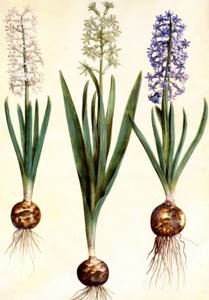
Carefully dig up the bulb, rinse it in running water and dry it in the sun. If there are children on it, it is better to separate them from the adult bulb before planting in the autumn. Small children should not be separated from the mother's bulb.

It is best to store planting material in unclosed paper bags in a dry and warm place. It is convenient to attach labels with the name and color of the variety to the bags.

Hyacinth varieties
The Netherlands was and remains the main producer of plants, and their cultivation began in the 18th century. Even then, many varieties of this bright representative of bulbous plants were grown.
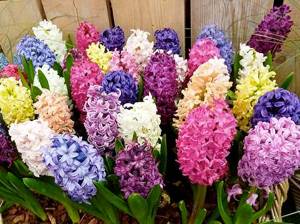
Currently, more than 100 varieties of hyacinth are known. The most common colors are white, blue and cyan, pink, yellow, purple and red. The most popular varieties are those with blue and blue flowers, for example, “Blue Jacket”, “Delft Blue”. Pink “Anna-Marie”, “Lady Derby” and “Pink Petal”, purple-violet “Amethyst”, carmine “Jan Bos” and orange “Gypsy Queen” are very prized in gardening. A real rarity are the varieties “Midnight” and “Mystic” with black inflorescences.
Possible diseases and pests
If you grow hyacinth outdoors in a sunny place, the plants practically do not suffer from potential diseases and pests. Flowers most often get sick in greenhouses or during improper forcing.
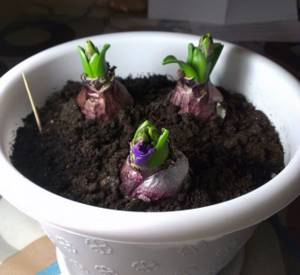
Hyacinths in open beds may feel bad only in the following cases:
- if infected planting bulbs have already been purchased;
- in the prepared bed in the spring there was a long stagnation of melt water;
- diseases could be caused by fresh manure or an excess of other fertilizers;
- thickened planting also contributes to the spread of infection on the bulbs;
- the planting material was not pickled in manganese before planting.
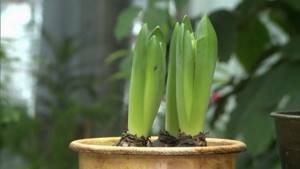
A sick plant is stunted in growth, its flower stalks are bent, the foliage quickly turns yellow and withers. Most often, the flower is affected by yellow bacterial rot, which quickly turns the bulb into a rotten, fetid mass. The affected bulbs must be burned, and the soil where the diseased bulb was located must be treated with bleach.
Mole crickets, onion root mites and flower flies are the main enemies of hyacinths. The larvae of flower flies infect the bottom of the bulb, and the mole cricket and mite destroy the bulb as a whole. To combat them, special drugs should be used.

If you follow all the simple rules and care techniques, these wonderful flowers will decorate spring gardens and summer cottages for many years to come. Hyacinths not only have an incomparable appearance, but also a magical aroma. Growing hyacinths is not a very painstaking and difficult task, as it might seem at first. But spring gardens, decorated with hyacinths, will sparkle with new colors and give gardeners a wonderful mood and bright emotions!
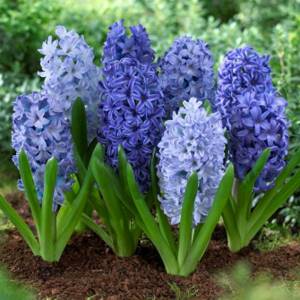
Blooming hyacinths
Depending on the variety, these flowers may bloom at different times. Blue hyacinths usually bloom first, followed by pink, then white and red flowers. At the next stage, lilac hyacinths bloom and yellow hyacinths complete the whole process.
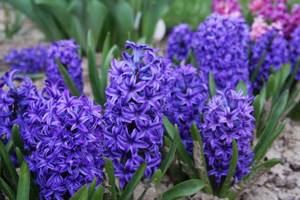
This plant has large racemose inflorescences, each of which can contain up to 30 flowers. These are very fragrant flowers, the flowering period of which is 2-3 weeks.
Quite often there is a situation when a plant produces short peduncles, this may be for the following reasons:
- the bulbs were at rest for an insufficient period of time;
- during forcing, the temperature regime was not observed, and it was higher than recommended;
- during forcing there was very bright lighting;
- the plant does not have enough nutrition.
After the plant has flowered, it must be fed with phosphate and potassium fertilizers, this will allow the bulb to gain nutrients and go into a normal dormant state.
One bulb may not produce children for many years. In order for them to appear, a cross-shaped cut must be made on its bottom, after which small bulbs appear in this place.
Photo of hyacinth
Meaning of hyacinth flower
According to legend, hyacinths appeared on the shores of Holland after a shipwreck. A box fell out of a merchant ship and broke on the coastal rocks. The bulbs have taken root and sprouted. It is believed that this is how the magnificent flower came to Holland.
Scientists believe that the homeland of hyacinth is Mesopotamia, the Balkans and Asia, where the flower was cultivated and transferred to gardens.
The word “hyacinth” itself came to us from Germany, and to the Germans from the ancient Romans. Translated, it means “purple cinquefoil” - this is how the flower was named for its natural (then only) color and shape of the leaves, which look like military weapons.
Hyacinth is translated from Greek as “flower of rain.” It owes this poetic name to the fact that in its homeland, in Asia Minor, it blooms with the first warm spring rains. Girls braid fragrant hyacinths in their hair on all holidays.
Hyacinth - types and photos
Until recently, it was believed that the genus Hyacinth includes only one species - Oriental Hyacinth (Hyacinthus orientalis) - which is the ancestor of all cultivated forms and varieties. Currently there are 3 types:
Oriental hyacinth (Hyacinthus orientalis)
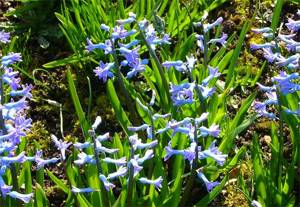
Described in detail. Distributed in Greece, Asia Minor and on the Adriatic Coast of the Balkan Peninsula. The height of the peduncles is about 30 cm, the flowers are blue-violet.
Hyacinth Litvinowii (Hyacinthus litvinowii)
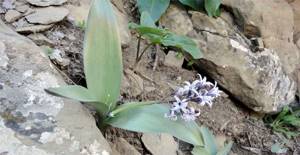
Very similar to the previous one, but the rosette is more spreading, the leaves are shorter and wider, and the peduncle is also shorter. The flowers are light blue with a dark stripe at the bottom of each petal.
Transcaspian hyacinth (Hyacinthus transcaspicus)
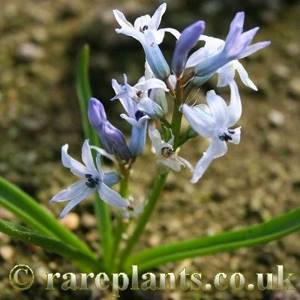
Found in mountain forests of North-Eastern Iran and Turkmenistan. The rosette consists of 2-3 erect leaves up to 16 cm long, the height of the peduncle is up to 20 cm. The inflorescence contains up to 10 small light blue flowers. Blooms in May.
Botanists argue about several other species, but this matters only to the botanists themselves. It is important for the florist to know that almost exclusively varieties of Oriental Hyacinth are found in cultivation.
What flowers are combined with in a bouquet, for what events and to whom it is customary to give them?
Lilac and violet colors can be used when making a wedding bouquet. These modest and fragrant flowers will add tenderness, charm and a spring mood to the bride's bouquet.
Hyacinths in pots are the most win-win option; a gift as a decoration will remain for a long time.
All articles about hyacinths on the site can be read by following this link...
A bouquet of lilac and purple hyacinths can be given for spring and children's holidays, birthdays (unless of course it's an anniversary) or just for no reason. Hyacinths of lilac and purple varieties also look great in a mixed bouquet. Hyacinths as a bouquet can be presented to any age category. Such a bouquet will delight you with its freshness, naive simplicity and persistent spring aroma.
